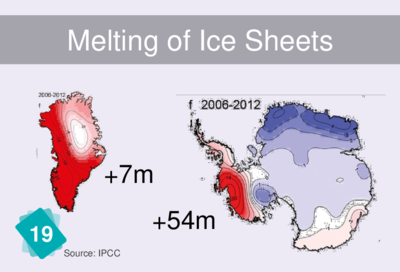En-en adult card 19 melting of ice sheets: Difference between revisions
(First draft of entire page) |
m (Minor corrections) |
||
| Line 9: | Line 9: | ||
== Definition == | == Definition == | ||
An ice cap ( | An ice cap (or ice sheet) is a continental-scale mass of land ice, thick enough (between 1,600 and 6 400 m thick<ref>[https://www.nationalgeographic.org/encyclopedia/ice-sheet/ National Geographic Resource Library]</ref>) that covers most of the underlying rock formations. There are currently only two major ice sheets, one in Greenland and one in Antarctica.<ref>[https://archive.ipcc.ch/pdf/assessment-report/ar5/wg1/WG1AR5_SummaryVolume_FINAL_FRENCH.pdf IPCC, 2013: Glossary (Planton, S. (coord.)). P.196. (French)]</ref> | ||
We will speak here of melting of the ice caps when the total mass of ice has decreased over the period under consideration, whatever the processes involved. | We will speak here of melting of the ice caps when the total mass of ice has decreased over the period under consideration, whatever the processes involved. | ||
| Line 23: | Line 23: | ||
== References == | == References == | ||
<references /> | <references /> | ||
[[fr:Fr-fr_adulte_carte_19_fonte_des_calottes_glaciaires]] | |||
Revision as of 17:20, 13 February 2021
Card #19: Melting of Ice Sheets
| Causes | Consequences | |

|
Continental glaciers (or ice sheets) are in Greenland and Antarctica.
If they melt completely, they will cause a rise in ocean levels of 7 meters for Greenland and 54 meters for Antarctica.
During the last ice age, ice sheets were so much larger that the sea level was 120 m lower than today.
Explanation
These illustrations represent the gain or loss of mass of the caps, indicated in centimetres of water per year (cm of water/year) and measured gravimetrically. In blue the mass gain (because it snows more) and in red the losses (glaciers flow faster towards the ocean).
Definition
An ice cap (or ice sheet) is a continental-scale mass of land ice, thick enough (between 1,600 and 6 400 m thick[2]) that covers most of the underlying rock formations. There are currently only two major ice sheets, one in Greenland and one in Antarctica.[3]
We will speak here of melting of the ice caps when the total mass of ice has decreased over the period under consideration, whatever the processes involved.
To go further
Numbers
Between 2006 and 2015, the loss of ice from the ice caps is :
- 278 billion tonnes per year for Greenland
- 155 billion tonnes per year for the Antarctic[4].